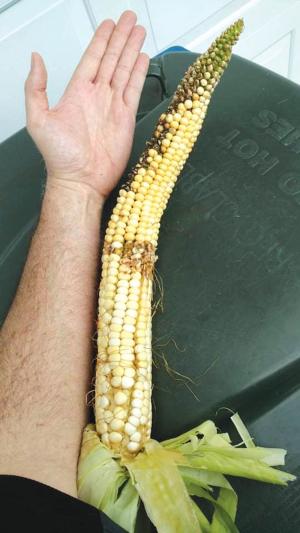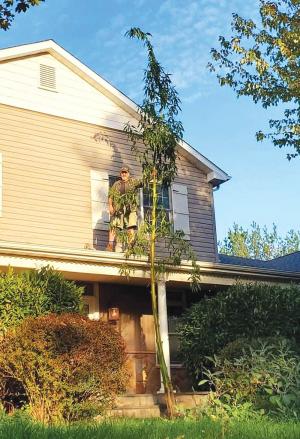2022 - Volume #46, Issue #6, Page #40
[ Sample Stories From This Issue | List of All Stories In This Issue | Print this story
| Read this issue]
Giant Plants Are His Passion
 |
 |
“I had the Guinness World Record for the tallest Amaranthus plant at 23 ft., 2 in. measured on October 15, 2007,” recounts Moore. “A friend of mine broke it a few weeks later, and today he holds the world record with one that is 27 ft., 10 in.”
Moore credits his mother for introducing him to gardening. She got his attention with a spider plant that shot up to his 6 ft., 3-in. height. However, it wasn’t until he planted sunflowers that reached more than 12 ft. that he was hooked. That was in the early 90’s.
Initially, Moore looked for commercial varieties of plants described as tall. Gradually he began sharing seed with researchers and other giant plant growers. He has sourced seed from USDA germplasm repositories and the International Maize and Wheat Improvement Center in Mexico.
Increasingly, he concentrates on his own landraces, varieties he developed and saved seed from. He rotates through heavy plantings of Amaranthus, corn and sunflowers.
When he gets new germplasm, he will plant it with seed he has selected from his own landrace. As the two cross-pollinate, he looks for seed that will produce ever taller plants.
“With corn, I always try to harvest at least 50 ears from 50 different plants each year,” he says. “Come spring, I may mix seed from two different harvests and plant.”
Recently he has been crossing multi-headed wild sunflower seed gathered by the USDA with his landrace giant sunflowers.
“I want sunflowers that are consistently 20 ft. tall and stand on their own,” says Moore. “I had one wild one that was 18 ft.”
Having plants that stand on their own is important to Moore. He has developed his own system to do that.
In March or April, he starts with fertilizer, several hundred pounds each of Azomite, alfalfa meal and Espoma garden food. Once the plants are in the ground, whether from seed, seedlings or the 3 to 4-ft. Amaranthus he starts from cuttings in his basement, he top-dresses.
“If a rainstorm is coming, I will top dress with urea pellets,” says Moore. “Nitrogen is always a limiting factor.”
One area where Moore differs from most other growers is the number of plants. He prefers to plant in masses and thin as they develop. This gives him time to pick out particularly fast-growing individuals. If one looks like a potential record breaker, it may get fish emulsion in season.
“If I plant 100 corn seeds, there’s a good chance at least one will be 25 ft. tall,” says Moore. “As the seeds grow and canopy, I thin them. When they canopy again, I will thin them again.”
Moore believes the mass plantings should include multiple species to provide the incentive to stretch out and grow tall. He seeks a balance between competition and the support they offer each other as roots intertwine. Amaranthus in particular can help support surrounding plants.
“Most people have a handful of plants,” says Moore. “I have a forest most of the year. By the end, with all the thinning, plants may be spread 4 ft. apart.”
Sufficient water is also key to these fast-growing, tall plants. That doesn’t mean an excess. Late friend and mentor Bernard Lavery (holder of 25 world records) advised ignoring plants early in the season, but watering progressively more as the season goes on.
“He told me a 10-ft. tall sunflower can take 10 gals. of water a day at the end of the season,” says Moore.
While Moore has no interest in providing constant support to his plants, he will step in if a windstorm is coming by throwing a couple hundred pounds of dirt against the base of a plant. Sometimes he will insert a temporary vertical support or use Velcro to pull plants together.
“I often plant corn in a circle,” he says. “If a wind is coming and the corn is tall, I will put a rope around the mass of plants and pull the tops in like a teepee.”
A challenge with giant plants is getting them through the growing season. Most are tropical in nature, and Moore’s New Jersey home is not.
“I’ve grown teosinte. It will get massive and fall over, but it will barely start to tassel,” says Moore. “I get lots of sterile 24 to 25-ft. Amaranthus.”
To help them along, he is trying grow lights placed above a plant like Amaranthus in late August and early September.
While Moore likes to share seed and ideas on speeding growth, not everything transfers from one garden to another. Soil type, heat, humidity and moisture all differ from one garden to another and one part of the country to another.
“There are several corn landraces that just don’t reproduce here, but they do fine in California,” says Moore. “My giant Amaranthus is a weed in Florida. It won’t produce seed here, but it can get enormous. A friend of mine in New York grew a clone of mine, and it was 7 ft. around at the base in one season.”
Moore advises interested FARM SHOW readers to join tall plant grower networks like www.bigpumpkins.com and other giant plant grower web pages. They can also join giant vegetable grower communities on Facebook or simply search the internet for information on giant plants.
Contact: FARM SHOW Followup, Brian Moore, 281 Goat Hill Rd., Lamberville, N.J. 08530 (ph 609-610-4147).

Click here to download page story appeared in.

Click here to read entire issue
To read the rest of this story, download this issue below or click here to register with your account number.




